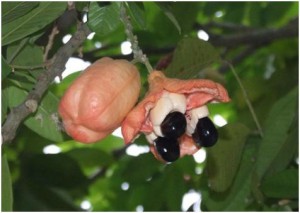Ackee and saltfish is Jamaica’s national dish and a breakfast staple. Like the identity of the island itself, the dish has a blend of British (saltfish) and West African (ackee) origins. The Ackee fruit is an African native crop introduced to the Caribbean by British slave traders.

The ackee tree (Blighia sapida) is indigenous to the tropical forests of West Africa. Although it is not popularly eaten there, it is cultivated in the region for several nonfood uses: Immature fruits are used to make soap; the wood from the tree is termite resistant and used for building; extracts from the poisonous seeds are taken to treat parasites and are sometimes used as a fish poison; topical ointment made from crushed ackee leaves is applied to the skin to treat headaches and ulcers. And the Ackee leaves are also good as a fodder for goats.
The Ackee tree grows up to 60 feet (18 m), and fruiting may occur year-round. Ackee fruit has a creamy texture and a mild flavor. It is commonly eaten with meat dishes as a side vegetable. It is very nutritious, high in fatty acids and rich in protein, potassium, iron, and Vitamin C. The fruit grows in red pods and is not entirely edible. Only the yellow arils—a fleshy appendage to each of the three large black seeds in the pod—can be eaten.
Both the skin and seeds of the ackee are poisonous. They contain toxic hypoglycins levels and can even be fatal. The mature ackee fruit splits open naturally when it is ripe, and then is picked and prepared. Care must be taken in harvesting the fruit at the right time and in the preparation of an ackee dish. The immature or overripe arils can also be poisonous. Ackee arils are generally boiled in a deep pot for about thirty minutes. The water is thrown away as it contains toxins. Even properly ripened ackee has been known to causeJamaican vomiting sickness, characterized by vomiting and hypoglycemia. However, the sickness is rare, and patients diagnosed with this condition generally suffer from chronic malnutrition and vitamin deficiencies. On the whole, properly picked and prepared ackee is delicious and considered safe to eat.
In tropical West Africa—where ackee trees are indigenous, well-adapted, and utilized for other purposes—increased awareness of the safe preparation and nutritious value of the ackee arils could support food security and rural incomes. After centuries abroad, the ackee crop could once again flourish in its native grounds.

Danielle Nierenberg, an expert on livestock and sustainability, currently serves as Project Director of State of World 2011 for the Worldwatch Institute, a Washington, DC-based environmental think tank. Her knowledge of factory farming and its global spread and sustainable agriculture has been cited widely in the New York Times Magazine, the International Herald Tribune, the Washington Post, and
other publications.
Danielle worked for two years as a Peace Corps volunteer in the Dominican Republic. She is currently traveling across Africa looking at innovations that are working to alleviate hunger and poverty and blogging everyday at Worldwatch Institute’s Nourishing the Planet. She has a regular column with the Mail & Guardian, the Kansas City Star, and the Huffington Post and her writing was been featured in newspapers across Africa including the Cape Town Argus, the Zambia Daily Mail, Coast Week (Kenya), and other African publications. She holds an M.S. in agriculture, food, and environment from Tufts University and a B.A. in environmental policy from Monmouth College.








